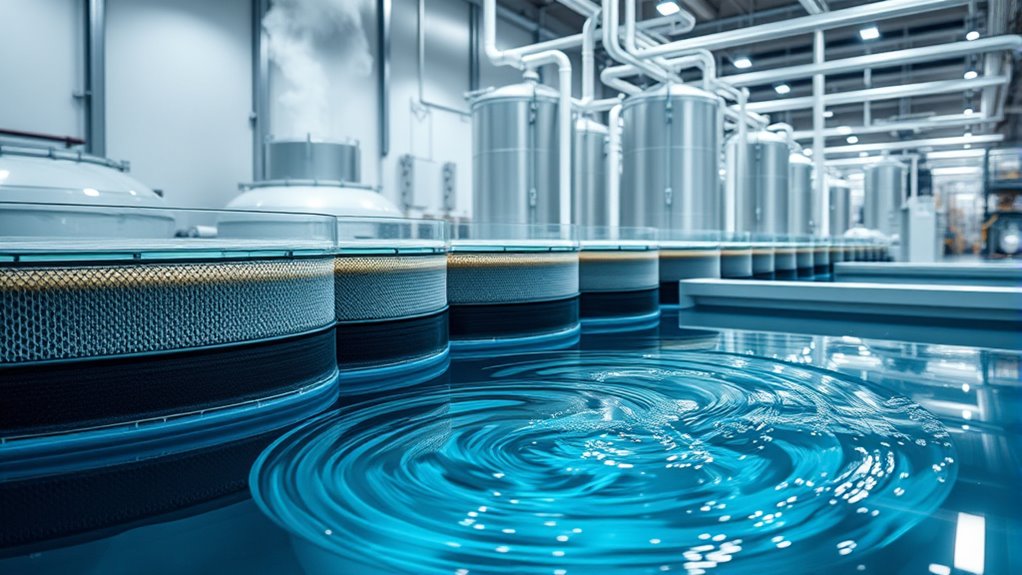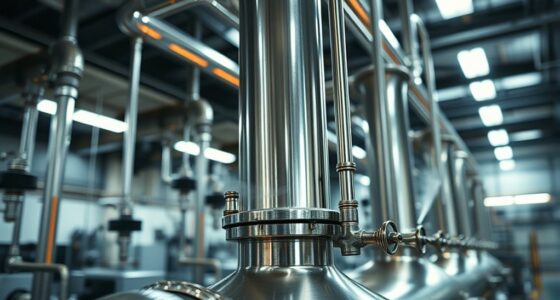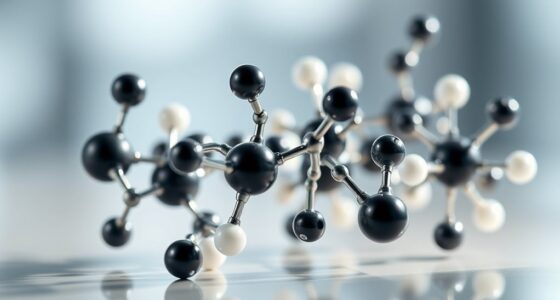Water treatment chemistry combines chemical and physical processes to remove pollutants and make water safe. It starts with chemical adjustments like coagulation and pH control, followed by physical steps such as filtration, sedimentation, and membrane separation. These methods target solids, microbes, and dissolved contaminants like salts and chemicals. Advanced processes like reverse osmosis and distillation enhance desalination. Understanding these fundamental interactions helps you grasp how clean water is produced—exploring further reveals even more fascinating techniques.
Key Takeaways
- Water treatment combines chemical processes (coagulation, disinfection) and physical methods (filtration, sedimentation) to remove contaminants.
- Filtration systems like activated carbon and membrane filtration trap particles, microbes, VOCs, and microplastics for cleaner water.
- Chemical adjustments (pH control, coagulants, disinfectants) optimize removal efficiency and prevent infrastructure fouling.
- Desalination methods (thermal distillation and reverse osmosis) separate salts and impurities, relying on chemical pretreatment and membrane stability.
- Proper water chemistry management enhances treatment performance, protects equipment, and ensures safe, high-quality drinking water.
Fundamentals of Chemical Processes in Water Treatment

Understanding the fundamentals of chemical processes in water treatment is essential because these processes directly remove contaminants and guarantee water safety. Chemical treatments work by changing the chemical properties of pollutants, making them easier to remove. For example, coagulation involves adding chemicals like iron salts or alum to neutralize charges on particles, causing them to clump together. Flocculation gently mixes the water to form larger flocs that sediment out. Oxidation converts dissolved substances into insoluble forms, aiding in organic matter removal. Disinfection, often using chlorine, kills bacteria, viruses, and other pathogens. Chemical reactions are fundamental to controlling the transformation of contaminants during treatment. Controlling chemical dosages ensures effective treatment without creating harmful by-products. Additionally, understanding water chemistry helps optimize these processes for efficiency and safety. These chemical processes play a crucial role in meeting safety standards, removing inorganic and organic contaminants, and maintaining water quality for consumption.
Physical Methods for Water Clarification and Purification
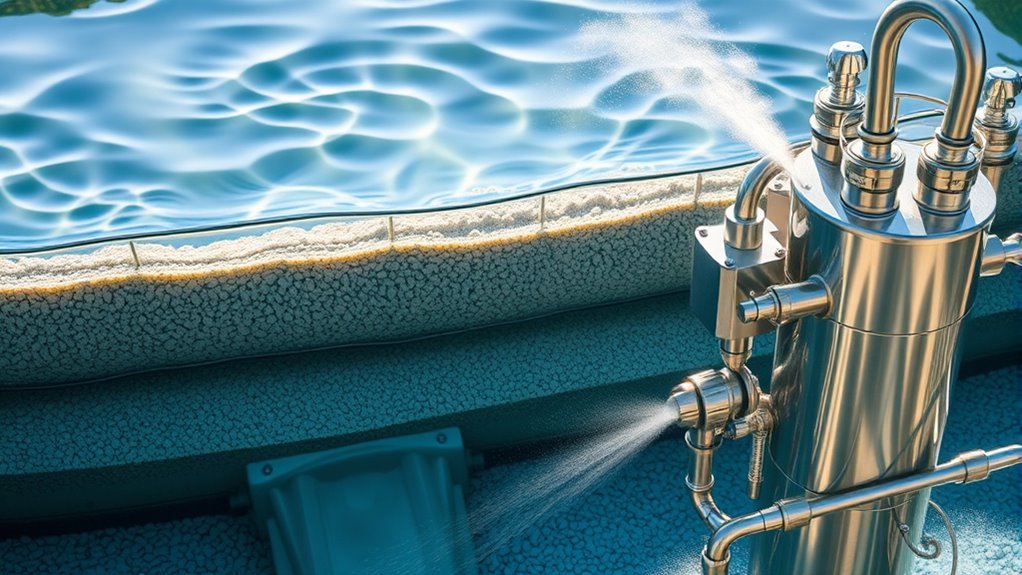
Physical methods for water clarification and purification play a essential role in removing impurities without relying on chemical treatments. You can use filtration systems like sand filters, microfiltration, or activated carbon to trap particles and improve water quality. These methods are often used as the first step in comprehensive water treatment processes. Sedimentation tanks let suspended particles settle naturally, while flotation systems use air bubbles to lift contaminants to the surface for removal. Centrifuges spin water at high speeds to separate out solids efficiently. Ultrasonic treatment employs sound waves to break apart or dislodge particles, and evaporation concentrates water while leaving impurities behind. Membrane filtration modern innovations like membrane bioreactors and nanofiltration combine physical separation with biological or molecular filtration, enhancing purification. These methods are cost-effective, environmentally friendly, and essential for ensuring clean water in both household and industrial applications.
Key Chemicals Used to Enhance Water Treatment
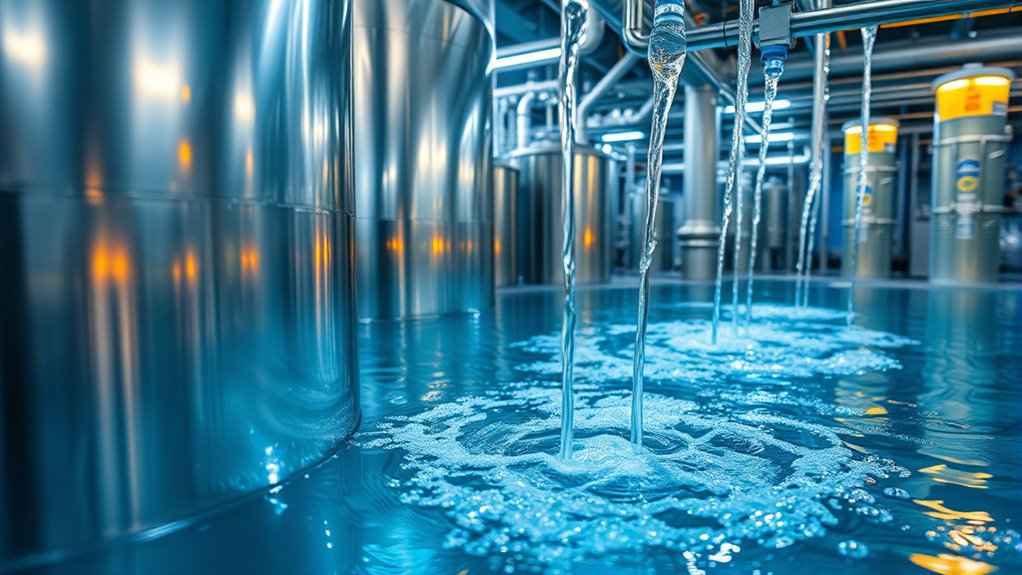
Chemicals play a vital role in enhancing water treatment processes by targeting specific impurities and guaranteeing safe, clean water. Oxidizing agents like sodium permanganate help remove iron, manganese, and organic compounds responsible for taste and odor issues.
Chemicals are essential for improving water quality by removing impurities and ensuring safety.
Chlorine and chlorine dioxide are essential disinfectants; chlorine kills pathogens, while chlorine dioxide offers effective microbial control without harmful by-products.
Coagulants such as ferric sulfate and alum aid in particle aggregation, making removal easier.
pH adjusting chemicals like lime slurry, sodium hydroxide, and hydrochloric acid optimize conditions for coagulation and prevent scaling.
Disinfectants, including chlorinated compounds and UV-reactive chemicals, guarantee microbial safety.
Corrosion and scale inhibitors like orthophosphate, sodium molybdate, and polyphosphates protect pipes and infrastructure, extending system lifespan and maintaining water quality.
Additionally, understanding the contrast ratio of a water treatment system can provide insights into its ability to distinguish between different levels of impurities, leading to more effective purification processes.
Strategies for Removing Specific Water Contaminants

Removing specific water contaminants requires targeted treatment strategies that effectively address their unique properties. To eliminate chlorine, VOCs, and odors, you rely on activated carbon filters that adsorb these chemicals. Reverse osmosis systems, with multi-stage setups, use carbon pre-filters to protect membranes and remove pharmaceuticals, PFAS, and microplastics. Ultrafiltration tackles microorganisms, macromolecules, and colloids while sparing minerals like calcium. For heavy metals, ion exchange resins swap ions like lead and cadmium, and RO membranes block dissolved metals. Microbial pathogens are controlled through UV disinfection, ceramic filters, or chlorination, depending on the application. Advanced oxidation processes and hybrid systems combine methods to target complex contaminants. Each strategy is designed to efficiently remove specific pollutants, ensuring safer, cleaner water tailored to the contaminant profile. Additionally, implementing regular maintenance of filtration systems helps maintain their effectiveness over time.
Integrating Treatment Stages for Optimal Water Quality

Integrating multiple water treatment stages guarantees that contaminants are addressed effectively at each step, resulting in higher water quality. You begin with coagulation and flocculation to chemically aggregate suspended solids, making removal easier in subsequent steps. Remote work can influence operational efficiencies by enabling flexible scheduling and resource management in treatment facilities.
Sedimentation then allows these flocs to settle, reducing solids before filtration. Filtration acts as a final barrier, removing remaining fine particles and ensuring water clarity, which boosts disinfection effectiveness.
Disinfection—via chlorination or UV—eliminates pathogens left after filtration. In conclusion, pH adjustments and supplementary treatments optimize water chemistry and taste.
This multi-stage approach ensures each contaminant class is targeted efficiently, minimizes chemical and energy use, and enhances overall system resilience. Proper integration of these stages guarantees safe, high-quality water suitable for drinking or reuse applications.
Advanced Techniques in Modern Water Treatment
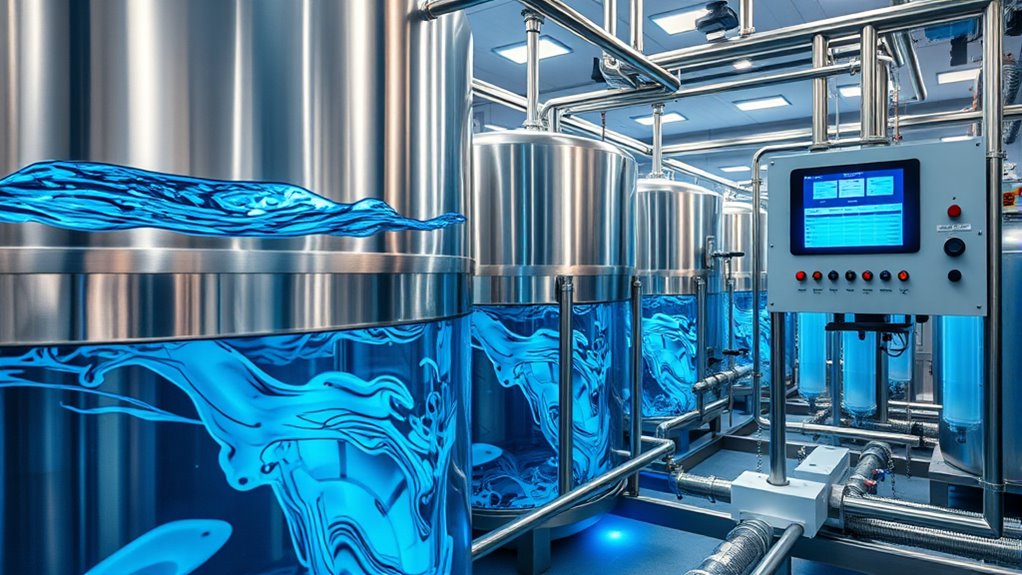
Have you ever wondered how modern water treatment achieves such high levels of purity? Advanced techniques like membrane technologies play a key role. Reverse osmosis (RO) uses semi-permeable membranes to remove ions, salts, heavy metals, and organics with high efficiency.
Nanofiltration membranes target divalent and larger molecules, offering selective removal and partial desalination. Membrane bioreactors (MBRs) combine biological treatment with filtration, boosting contaminant and pathogen removal.
These processes are widely used in municipal, industrial, and desalination sectors for reliable results. However, membrane fouling remains a challenge, requiring pretreatment and regular cleaning to keep performance superlative.
Additionally, advanced oxidation processes (AOPs) generate reactive radicals to break down persistent organic pollutants and inactivate pathogens, supporting stricter regulations and safer water reuse. Implementing real-time monitoring systems can help detect early signs of membrane fouling and optimize cleaning schedules, thereby maintaining efficiency.
The Role of Ph Adjustment and Coagulation Chemistry
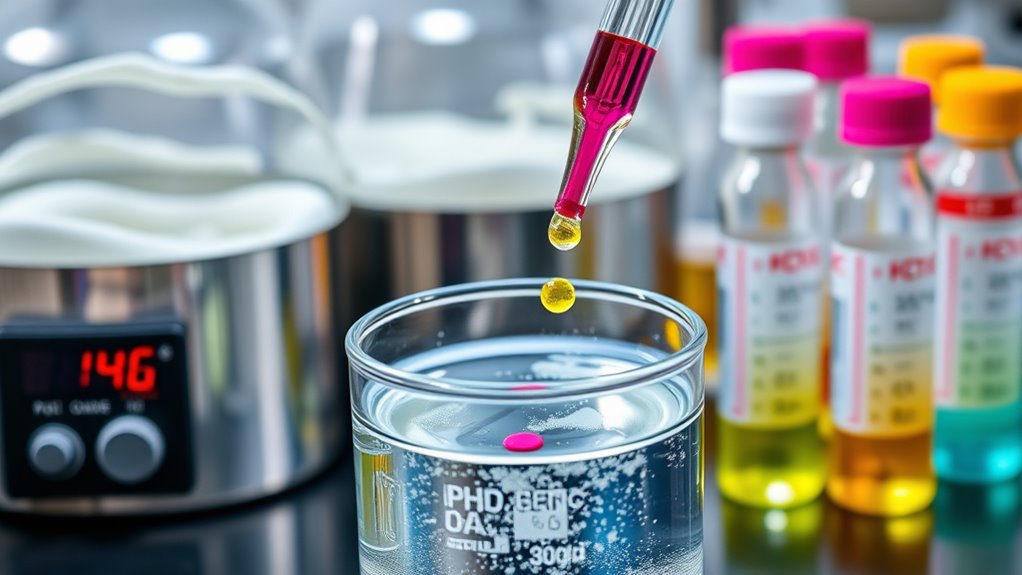
pH adjustment and coagulation chemistry work together to enhance water treatment efficiency by stabilizing particles and facilitating their removal. By adjusting pH with acids or alkalis, you optimize conditions for coagulants like alum or ferric chloride to work effectively. Proper pH guarantees these chemicals remain soluble and reactive, promoting the formation of larger flocs that settle out quickly. If the pH is too low or high, coagulation efficiency drops, leading to poor sedimentation and increased turbidity. Precise pH control prevents premature precipitation of coagulants and maintains stable treatment conditions. This process optimization improves turbidity removal, reduces organic matter, and prevents infrastructure damage.
Desalination Technologies and Their Chemical Foundations

How do different desalination technologies rely on chemical principles to remove salts from water? Thermal methods, like Multi-Stage Flash (MSF), heat saline water to vaporize it, relying on phase changes, with salts left behind. Multiple-Effect Distillation (MED) uses successive vaporization effects to improve efficiency, still depending on heat transfer and chemical stability of materials. Vapor Compression Distillation (VCD) recycles latent heat by compressing vapor, enhancing thermal efficiency.
Thermal desalination methods rely on phase changes and material stability to separate salts from water.
In membrane-based processes, like Reverse Osmosis (RO), semi-permeable membranes chemically engineered from polyamide or cellulose acetate allow water molecules through while rejecting salts.
Electrodialysis (ED) employs ion-exchange membranes that selectively transport ions under an electric field.
Pretreatment chemicals like anti-scalants and biocides prevent membrane fouling, preserving chemical and operational integrity.
Water chemistry principles underpin many of these processes, ensuring the materials and methods used are effective and sustainable.
Frequently Asked Questions
How Do Water Treatment Chemicals Affect Aquatic Ecosystems?
You should know that water treatment chemicals can harm aquatic ecosystems considerably. They’re toxic to fish and other aquatic life, disrupting their breathing, growth, and reproduction.
These chemicals can also kill beneficial microbes, impair nutrient cycling, and cause algal blooms through nutrient pollution.
Persistent residues bioaccumulate, leading to long-term ecological damage, dead zones, and reduced biodiversity.
Ultimately, these chemicals threaten the balance and health of aquatic environments you depend on.
What Are the Environmental Impacts of Chemical Discharges From Treatment Plants?
You might think chemical discharges are just a regulatory issue, but they threaten ecosystems, harm wildlife, and endanger human health. These discharges cause water pollution, deplete oxygen, and contaminate groundwater.
They also lead to habitat destruction, reduce biodiversity, and increase energy use. By understanding these impacts, you realize how vital it’s to improve treatment processes, reduce chemical overuse, and protect the environment for future generations.
How Is Chemical Dosage Optimized for Different Water Qualities?
You optimize chemical dosage by continuously monitoring key water quality parameters like BOD, COD, TSS, turbidity, and pH with automated sensors.
These real-time data allow you to adjust chemical doses accurately, ensuring effective contaminant removal without waste.
What Safety Measures Are in Place for Handling Treatment Chemicals?
Did you know improper chemical handling can cause accidents in 75% of water treatment incidents? You’re responsible for safety, so always guarantee chemicals are correctly labeled and stored in secure, designated areas.
Use color-coded labels, PPE, and follow SDS guidelines.
Regular training, emergency drills, and operational checklists help prevent mishaps.
Remember to segregate incompatible chemicals and implement engineering controls to protect yourself and the environment effectively.
How Do Emerging Contaminants Influence Current Water Treatment Chemistry?
Emerging contaminants challenge your current water treatment chemistry because they’re resistant to traditional methods like oxidation and filtration.
You need to adapt by exploring advanced techniques such as membrane filtration, advanced oxidation, and adsorption to effectively remove these complex chemicals.
These contaminants also require stricter monitoring and innovative solutions to prevent environmental and health risks, prompting you to stay updated on evolving regulations and treatment technologies to guarantee safe, clean water for all.
Conclusion
As you explore water treatment, you’ll find that combining chemistry with technology creates surprisingly effective solutions. From simple filtration to advanced desalination, each step relies on precise chemical reactions that often seem to align by chance. It’s almost like a dance, where every chemical and process moves in harmony to produce clean, safe water. So, as you dive deeper, remember—sometimes, the most complex treatments are just chemistry’s elegant coincidence at work.
